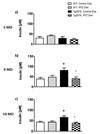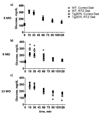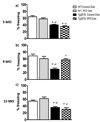Rosiglitazone reversal of Tg2576 cognitive deficits is independent of peripheral gluco-regulatory status
- PMID: 20709114
- PMCID: PMC2975872
- DOI: 10.1016/j.bbr.2010.08.002
Rosiglitazone reversal of Tg2576 cognitive deficits is independent of peripheral gluco-regulatory status
Abstract
Converging lines of evidence associate gluco-regulatory abnormalities and peroxisome-proliferator-activated receptor (PPAR) gamma function with increased risk for Alzheimer's disease (AD). In this study, we used the Tg2576 AD mouse model to test the hypothesis that cognitive improvement following 1 month of PPAR gamma agonism with rosiglitazone (RTZ) correlates with peripheral gluco-regulatory status. We assessed cognition and peripheral gluco-regulatory status of Tg2576 mice following 1 month treatment with RTZ initiated prior to, coincident with, or after, the onset of peripheral gluco-regulatory abnormalities (4, 8, and 12 months of age, respectively). Whereas 5 months old (MO) and 13 MO Tg2576 did not gain cognitive improvement after 1 month treatment with RTZ, 9 MO Tg2576 mice exhibited reversal of associative learning and memory deficits. Peripheral gluco-regulatory abnormalities were improved in 9 and 13 MO Tg2576 with RTZ treatment; RTZ treatment had no effect on the normal glucose status of 5 MO Tg2576 mice. These findings suggest that RTZ-mediated cognitive improvement does not correlate with peripheral gluco-regulatory abnormalities per se, but reflects the age-dependent mechanistic differences that underlie cognitive decline in this mouse model.
Copyright © 2010 Elsevier B.V. All rights reserved.
Figures




References
-
- 2009 Alzheimer's disease facts and figures. Alzheimers Dement. 2009;5(3):234–270. - PubMed
-
- Larson EB, Kukull WA, Katzman RL. Cognitive impairment: dementia and Alzheimer's disease. Annu Rev Public Health. 1992;13:431–449. - PubMed
-
- Forstl H, Kurz A. Clinical features of Alzheimer's disease. Eur Arch Psychiatry Clin Neurosci. 1999;249(6):288–290. - PubMed
-
- Luchsinger JA, Tang MX, Shea S, Mayeux R. Hyperinsulinemia and risk of Alzheimer disease. Neurology. 2004;63(7):1187–1192. - PubMed
-
- Ott A, Stolk RP, van Harskamp F, Pols HA, Hofman A, Breteler MM. Diabetes mellitus and the risk of dementia: The Rotterdam Study. Neurology. 1999;53(9):1937–1942. - PubMed
Publication types
MeSH terms
Substances
Grants and funding
LinkOut - more resources
Full Text Sources
Other Literature Sources
Medical
Molecular Biology Databases

